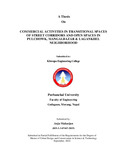Please use this identifier to cite or link to this item:
https://elibrary.khec.edu.np:8080/handle/123456789/513Full metadata record
| DC Field | Value | Language |
|---|---|---|
| dc.contributor.advisor | Dr. Subik Shrestha | - |
| dc.contributor.author | Maharjan, Anju | - |
| dc.date.accessioned | 2023-06-09T08:51:12Z | - |
| dc.date.available | 2023-06-09T08:51:12Z | - |
| dc.date.issued | 2022-09 | - |
| dc.identifier.uri | https://elibrary.khec.edu.np/handle/123456789/513 | - |
| dc.description.abstract | This research examines transitional spaces broadly and commercial transitional space. The site chosen is twelve pockets along three streets were selected to determine the characteristics of transitional spaces. . In order to examine these commercial activities occurring in transition spaces, the thesis will examine two streets in the historic part of Patan. The study includes the physical, visual, and quality evaluation of the selected street corridor and its connected neighborhood space in the core area of Patan. With the growing population, commercialization is not only in business but also in lifestyles, and the impact is visible in the social, economic, and cultural activities of Nepalese people. The settlement pattern, spatial structures, and spaces of those towns are exposed to an inevitable process of transformation along with modernization. The transitional space acts as an interaction between life and form, creating a greater sense of journey and place within the urban environment. The main character of Transitional space is “Flexibility” to change according to the needs of the user. Humans, their economic and noneconomic activities, which area transitional spaces, vibrantly occupy parts of these open space, courtyards, streets, and intersections. This research aims to explore the present-day scenario of commercial streets by considering transition spaces as important points of activity. It is a research to describe what sorts of Transitional Spaces are occurring in the present urban spaces in the selected neighborhood. The existing maps of old city towns show that the network of open spaces (streets, nodes, chowks, courtyards) played important role in contributing to the commercial activities of the town. With the observation and field study of the selected area, the roles, characters, and multiple activities in transitional spaces, simultaneously coexisting commercial activities in the same space are explored during the research. A Commercial Transitional Space Metric (CTSM) was computed based on the behavioral mapping/observation of passers-by, shoppers, and vendors. The results of CTSM highlight those transitional spaces have the flexibility of use in terms of open street vendors i.e. commercial activities and attract the stay activities of the people passing through the street. Additionally, other behavioral components and urban design qualities related to the transitional spaces of Patan’s neighborhoods. These findings imply that for current and future towns should learn and insert these kind of commercial transitional spaces to cater the vibrant human movement. | en_US |
| dc.language.iso | en | en_US |
| dc.title | COMMERCIAL ACTIVITIES IN TRANSITIONAL SPACES OF STREET CORRIDORS AND OPEN SPACES IN PULCHOWK, MANGALBAZAR & LAGANKHEL NEIGHBORHOOD | en_US |
| dc.type | Thesis | en_US |
| local.college.name | Khwopa Engineering College | - |
| local.degree.name | MSc in Urban Design and Conservation | - |
| local.degree.level | Masters | - |
| Appears in Collections: | Master of Science (M.Sc) in Urban Design and Conservation | |
Files in This Item:
| File | Description | Size | Format | |
|---|---|---|---|---|
| Anju-Maharjan-Final-Thesis-2022-Updated-Report-29th-september-2022.pdf Restricted Access | 16.64 MB | Adobe PDF |  View/Open Request a copy |
Items in DSpace are protected by copyright, with all rights reserved, unless otherwise indicated.
